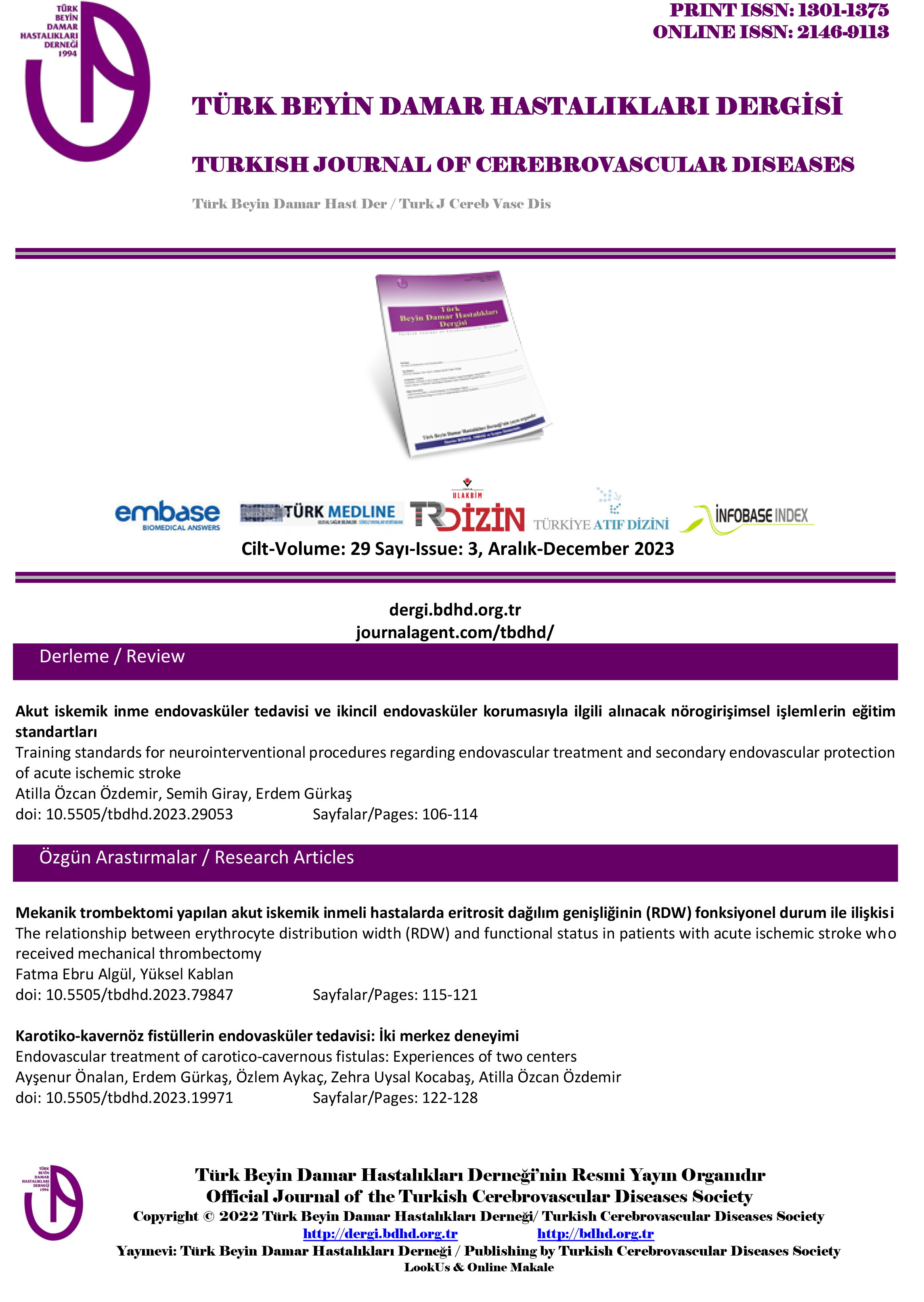STROK ÖNCESİ VE STROK SONRASI BAŞAGRILARINDA LEZYONA AİT ÖZELLİKLER
Şerefnur ÖZTÜRK1, Taşkın DUMAN1, Serap KAZAK1, Şenay ÖZBAKIR1Ankara Numune Hastanesi Nöroloji KliniğiStrok öncesi ve sonrası ortaya çıkan başağrısının oluşum mekanizmaları için ağrıya duyarlı yapıların gerilmesi, enflamasyon, vazoaktif maddelerin salınması, psikolojik stres faktörleri ileri sürülmüş ve hangi mekanizmanın ağırlıklı olduğu konusu netleşmemiştir. Bu çalışma akut strok hastalarında strok öncesi ve sonrası ortaya çıkan başağrısının oluşum mekanizmasında rol oynayabilecek klinik özellikleri, lezyona ait özelliklerle başağrısının ilişkisini ve strok risk faktörleri ile ağrı arasında bağlantı olup olmadığını araştırmak amacıyla planlandı. Hemorajik ve iskemik strok tanısı ile izlenen 200 hasta çalışmaya alındı. Hastalardan 125 i (%62,5) başağrısının varlığı ve özellikleri hakkında bilgi veremezken, 75 hastadan bilgi alınabildi. Başağrısı olan 52 hastanın 12 sinde ağrı strok öncesi, 9 unda strok sonrası, 31 inde ise strok öncesinde ve sonrasında mevcuttu. Ağrı tipi 34 hastada künt ve devamlı, 15 hastada zonklayıcı, 3 hastada sıkıştırıcı nitelikteydi. Ağrı lokalizasyonu 28 hastada unifrontal, 10 hastada bifrontal, 3 hastada temporal, 10 hastada oksipital, 2 hastada yaygın idi. Başağrısı olan (yaş ort. 60,98±12,16) ve olmayan ( yaş ort. 64,47±13,37) hastalar arasında yaş farklılığı yoktu. Başağrısı olan ve olmayan grupta lezyonunun arter alanı dağılımı farksızdı. Başağrısı olan grubunda dağılım ACA %4,1, MCA %69,3, PCA %15,1, serebellar %4,1, multipl %6,8 şeklinde izlendi. Başağrısı olan grupta lezyonun kitle etkisi ve ödem varlığı daha yüksek oranda bulundu (sırasıyla p=0,013 ve p=0,035). Atrofi oranı ağrısı olmayan grupta fazlaydı (P=0,034). Lezyon lateralizasyonu ve anterior veya posterior arter sisteminin tutulumu ile ağrı gelişimi arasında bağlantı bulunmadı. Başağrısı oranı kadın hastalarda belirgin olarak yüksek bulunurken (p=0,017), HT, kalp hastalığı ve DM ağrı ile bağlantısız bulundu. Obezite ise ağrı gelişimi ile bağlantılıydı (p=0,016). Başağrısı strok öncesi ve sonrası olanlarda atrofi, cinsiyet, DM, HT, kalp hastalığı, lezyonun kitle etkisi, ödem varlığı, anterior ve posterior sistem tutulumu ile ağrı gelişimi bağlantısız bulundu. Sonuç olarak başağrısı olan strok hastalarında lezyona ait kitle ve ödem etkisinin daha yüksek, atrofinin daha az oranda saptanması ağrıya duyarlı yapıların gerilmesinin stroka ilişkin başağrısı gelişiminde etkili mekanizma olduğunu düşündürmektedir. Ağrının oluş sıklığı ve tipi risk faktörleri ve tutulan arter alanlarından bağımsız görünmektedir. Strok sırasında oluşan başağrısı tedavisinde de bu durum dikkate alınmalıdır.
Anahtar Kelimeler: Başağrısı, İskemik, Hemorajik, Kitle etkisi, Odem, Strok.LESION RELATED FEATURES iN HEADACHE iN PRESTROKE AND POSTSTROKE STAGES
Şerefnur ÖZTÜRK1, Taşkın DUMAN1, Serap KAZAK1, Şenay ÖZBAKIR1Distortion, deformation or streching of pain sensitive intracranial structures, inflammation, releasing of vasoactive amines, psychological stress factors were suggested as mechanisms in occurrence of headache before and after stroke, but it is not clear which mechanism is important. This study was planned to evaluate clinical features which can be important in the mechanism of headache before and after stroke, relations between features of lesions and headache and relations between stroke risk factors and headache. Headache of the patients were divided into two subgroups firstly; sentinel and onset headache. Location, onset, duration, character and severity of the headache were noted. Demographic features of the patients and associated stroke risk factors were recorded. Lesion features as location, nature, size, atrophy and edema on CT were evaluated. 200 consecutive patients with acute ischemic and hemorrhagic stroke were included in the study. 125 of the patients (62.5%) could not inform us about presence of headache and its features because of their consciousness level and aphasia, 75 patients could inform us about their headache. 12 of 52 patients with headache had prestroke (sentinel), 9 had poststroke (onset), 31 had both of the stages of headache. The types of headache were boring and persistent in 34, throbbing in 15, nagging in 3 patients. Location of the headache was unifrontal in 28 patients, bifrontal in 10 patients, temporal in 3, occipital in 10 and diffused in 2 patients. There was not significant difference for ages between patients with headache (mean age 60.98± 12.16) and without headache (mean age 64.47± 13.37). the arterial distributions of the lesions were not different in the patients with or without headache. Arterial distributions were found 41% for ACA, 69.3% for MCA, 15.1% for PCA, 4.1% for cerebellar and 6.8% for multiple distribution in the patient with headache. The rate of mass effect of the lesion (p=0.013), and the presence of edema (p=0.035) were significantly higher in the patients with headache. The rate of atrophy was higher in the patients without headache (p=0.034). There were not any relation between occurrence of headache and whether lesion located in anterior or posterior arterial distibutions and lesion lateralization. Presence of headache was found higer in the female patients (p=0.016) but no relation was found with HT, heart diseases and DM. There is a significant relation between presence of headache and obesity (p=0.016). There was not any difference for atrophy, gender, DM, HT, heart disease, the mass effect of the lesion, edema, involvement of anterior or posterior system between patients who had sentinel headache and the patients with onset headache. As a result, the higher incidence of presence of mass effect of the lesion and lesion associated edema and the lower rate of atrophy in the stroke patients who had headache are thought that distortion of pain sensitive structures is the most important mechanism of headache in stroke. This must be considered in the management of the headache during stroke course.
Keywords: Edema, Headache, Hemorrhage, Ischemia, Mass affect, Stroke.Makale Dili: Türkçe










